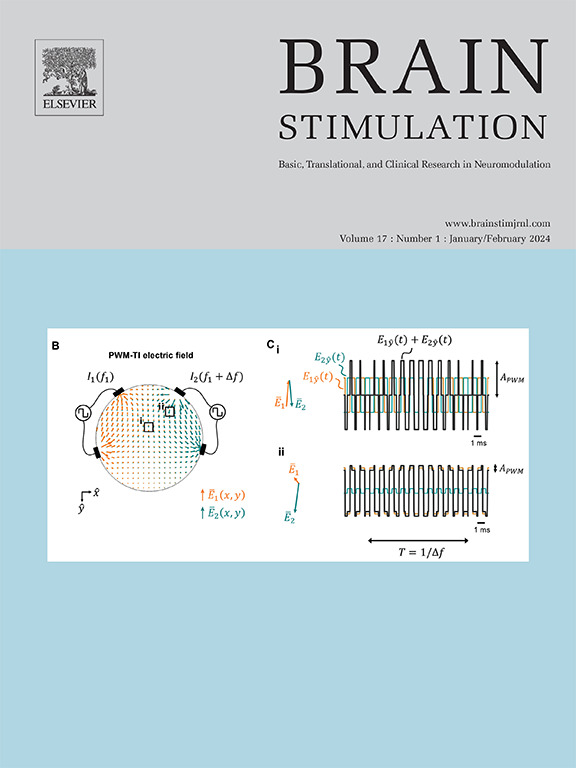非周期性活动作为癫痫发作和神经调节的生物标志物。
IF 7.6
1区 医学
Q1 CLINICAL NEUROLOGY
引用次数: 0
摘要
越来越多的证据表明,神经调节对癫痫的疗效是由神经网络重构和神经状态介导的。癫痫网络相关的病理生理与非周期指数的变化有关,非周期指数描述了频率和功率之间的反比关系,并与突触水平的过程有关。本研究旨在评估周期性和非周期性活动、疾病状态和反应性刺激之间的关系。方法:记录13例接受反应性神经刺激治疗的癫痫患者的慢性颅内脑电图。记录包括临床注释的癫痫发作,由设备检测到的癫痫样活动间期(IEA)触发的刺激,以及无刺激的间期进行分析。确定了多个IEA周期,并按周期阶段对记录进行了分类。利用建立的算法将功率谱参数化为周期分量和非周期分量。结果:非周期指数在癫痫发作和刺激前间隔时间比无刺激间隔时间大,刺激后下降。在癫痫发作前12小时观察到非周期性指数升高。多周期IEA周期上升阶段非周期指数较大。周期性α和β功率在癫痫发作、刺激前间隔和高风险(上升和/或峰值)IEA周期阶段较大,而周期性θ和γ功率表现出可变关系。在任何研究频段,刺激后或癫痫发作前几小时内,周期性功率没有变化。结论:非周期指数与瞬时和多期病情严重程度呈正相关,与治疗刺激负相关。非周期性活动可能成为疾病状态和治疗反应的实用生物标志物,以指导癫痫的神经调节。本文章由计算机程序翻译,如有差异,请以英文原文为准。
Aperiodic activity as a biomarker of seizures and neuromodulation
Introduction
Mounting evidence suggests the efficacy of neuromodulation for epilepsy is mediated by network remodeling and neural state. Epilepsy network related pathophysiology has been associated with variation in the aperiodic exponent, which describes the inverse relationship between frequency and power and has been linked to synaptic-level processes. This study sought to assess relationships between periodic and aperiodic activity, disease state, and responsive stimulation.
Methods
Chronic intracranial EEG was recorded from 13 patients undergoing responsive neurostimulation for epilepsy. Recordings containing clinician-annotated seizures, stimulation triggered by device-detected interictal epileptiform activity (IEA), and stimulation-free interictal periods were analyzed. Multidien IEA cycles were identified, and recordings were classified by cycle phase. Power spectra were parameterized into periodic and aperiodic components using an established algorithm.
Results
The aperiodic exponent was larger during seizures and pre-stimulation intervals than stimulation-free interictal recordings, and decreased following stimulation. A rise in aperiodic exponent was observed in the 12 h preceding seizures. Larger aperiodic exponent was observed during the rising phase of multidien IEA cycles. Periodic alpha and beta power were larger during seizures, pre-stimulation intervals, and high-risk (rising and/or peak) IEA cycle phases, whereas periodic theta and gamma power exhibited variable relationships. Periodic power did not change after stimulation or in the hours before seizures for any studied frequency band.
Conclusions
The aperiodic exponent was positively related to instantaneous and multidien disease state severity and negatively related to therapeutic stimulation. Aperiodic activity may emerge as a practical biomarker of disease state and treatment response to guide neuromodulation for epilepsy.
求助全文
通过发布文献求助,成功后即可免费获取论文全文。
去求助
来源期刊

Brain Stimulation
医学-临床神经学
CiteScore
13.10
自引率
9.10%
发文量
256
审稿时长
72 days
期刊介绍:
Brain Stimulation publishes on the entire field of brain stimulation, including noninvasive and invasive techniques and technologies that alter brain function through the use of electrical, magnetic, radiowave, or focally targeted pharmacologic stimulation.
Brain Stimulation aims to be the premier journal for publication of original research in the field of neuromodulation. The journal includes: a) Original articles; b) Short Communications; c) Invited and original reviews; d) Technology and methodological perspectives (reviews of new devices, description of new methods, etc.); and e) Letters to the Editor. Special issues of the journal will be considered based on scientific merit.
 求助内容:
求助内容: 应助结果提醒方式:
应助结果提醒方式:


